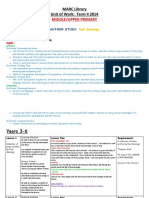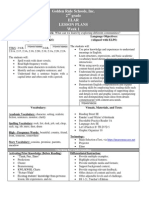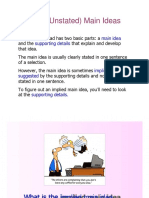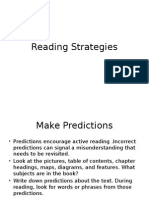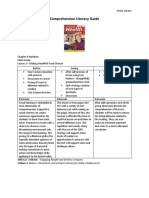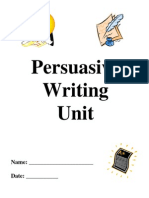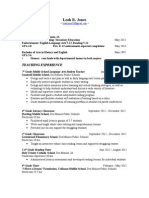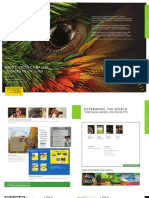Differentiated Lesson Plan
Differentiated Lesson Plan
Uploaded by
leahjones73Copyright:
Available Formats
Differentiated Lesson Plan
Differentiated Lesson Plan
Uploaded by
leahjones73Original Description:
Copyright
Available Formats
Share this document
Did you find this document useful?
Is this content inappropriate?
Copyright:
Available Formats
Differentiated Lesson Plan
Differentiated Lesson Plan
Uploaded by
leahjones73Copyright:
Available Formats
Differentiated Persuasion Lesson Plan Topic: Identifying elements of persuasion in a persuasive text Length of class: 50 minutes Who are
your students and what are their specific learning needs? My students are a 7th grade language arts class. Approximately 4-6 students in each class are advanced, while 4-6 in each class read below grade level and struggle with most assignments. The remaining 12-16 students fall in the middle, reading at grade level. Some students have a 504 plan that allows extended time or for behavior.
Standard(s) to be addressed: Cite textual evidence to support analysis of what the text says explicitly as well as inferences drawn from the text. (RL.7.1.) Trace and evaluate the argument and specific claims in a text, distinguishing claims that are supported by reasons and evidence from claims that are not. (RI.6-8.) Present claims and findings, sequencing ideas logically and using pertinent descriptions, facts, and details to accentuate main ideas or themes; use appropriate eye contact, adequate volume, and clear pronunciation. (SL.7.4.) Enduring Understandings/Essential Questions targeted in this lesson (for units created using the Understanding By Design framework only): How can I influence others? All arguments must be supported by strong evidence in order to be effective. Learning Objectives for this lesson (Written using verbs from Blooms Taxonomy): Teacher - Given modeling and guided practice, students will be able to identify the elements of a persuasive argument in any persuasive text. Students - I can identify the elements of a persuasive argument in a persuasive text.
Teacher - Given modeling and guided practice, students will be able to work with a group of peers to share and develop ideas whenever they work in groups. Student - I can work with a group to share and develop good ideas. Student - I can apply my understanding of persuasion to create new ideas about this topic. (advanced only) Teacher - Given a text at their reading level, students will be able to identify facts and opinions and determine whether the facts effectively support the opinions proposed by the author. Students - I can evaluate arguments by identifying facts and opinions. Students - I can determine whether opinions are effectively supported by logical reasons and/or textual evidence.
Instructional method(s) chosen in this lesson: I chose to place my students into four groups based on their reading abilities. I wanted all of them to read a persuasive piece and look for the components of a persuasive text in it, but I knew while some might be overwhelmed by a grade level text, other more advanced students would be bored by it. I also created a tiered assignment so students with differing ability levels would have the best level of challenge for their abilities. I also tried to choose articles I thought would be thought provoking and engaging to this age level. I felt this would help students enjoy reading the articles, as well as listening to their classmates share out about articles they did not read. In addition, I asked the more advanced students to write out their answers to identifying the elements of persuasion. However, since writing a number of sentences can be very intimidating to struggling students, I asked them instead to use a highlighter to identify the elements of persuasion in their article. The students who are average grade level readers were allowed to use a combination of both methods. I also asked all the groups to share out because this creates some accountability to actually read the article and answer the questions. It also gives students practice in speaking and listening. Finally, this allows all the students to have exposure to four different persuasive arguments and their elements without having to read all four.
Materials/Resources: Texts: Advanced Why We Shouldnt Go to Mars (McDougal pg. 928),
Grade Level Do Professional Athletes Get Paid Too Much? (McDougal pg. 922) and Do Fame and Fortune Make You Happy?(Scholastic Scope, November 22, 2010) and Below Grade Level Are Commercials Making You a Junk Food Freak? (Adapted from Scholastic Scope, December 13, 2010) Composition notebooks, pencils, graphic organizer, list of questions.
Lesson Sequence: (How will you organize your lesson?)
1. Hook: Today were going to learn about crazy celebrities, trips to outer space, pizza and basketball players. 2. Briefly read learning objectives then cover agenda. 3. Explain to students that we will be looking for the elements of a persuasive argument while we read some different persuasive texts. Briefly review what the parts of a persuasive argument. (I will define and identify facts, opinions, hook, thesis/claim, and supporting details) Explain that they will partner read the text, then discuss and write about it. They will come back together as a group of six to discuss how to present it to the class everyone presents a part. Divide students into groups and hand each their articles and questions. All partner groups will identify the claim, supporting details, hook and in a four square summary. They will each independently answer a higher order question unique to their article. Send them to opposite corners of the room. 4. Answer any questions students may have about their specific directions and then circulate around the room while they partner read and discuss. 5. When a majority of students are done with their questions/discussions, have them meet with others with the same article, talk about their answers and decide how to present them. When about 10 - 15 minutes of class remain, bring them back together as a group. Have each group share out, starting with one of the middle groups. Itinerary for sharing out: Presenter 1: Read the title of your story and the hook. Presenter 2: Share the thesis and the main supporting details. Presenter 3: Share the answers to two questions (These will differ for each group) If there is downtime at the end, students can complete a quick write on which article
was most persuasive and why. I will also have 2 extra questions ready for each group in case they finish early.
Assessment of learning (How will I know if students achieved my learning objectives?) Informal assessment by listening to group discussion, reading each groups notes and listening to the group presentations.
You might also like
- Qar Strategy HandoutDocument18 pagesQar Strategy Handoutjuanne nurse100% (1)
- Paul Jennings Unit of Work 2014Document7 pagesPaul Jennings Unit of Work 2014Paula Medal MartínezNo ratings yet
- Apple Trouble Lesson PlanDocument5 pagesApple Trouble Lesson Planapi-288669283No ratings yet
- Grade 6 ArgumentationdocDocument51 pagesGrade 6 ArgumentationdocHeidi SwensonNo ratings yet
- Golden Rule Schools, Inc. 2 Grade Elar Lesson Plans Week 1Document3 pagesGolden Rule Schools, Inc. 2 Grade Elar Lesson Plans Week 1Constance Hildreth DouglasNo ratings yet
- Body Biography Assignment SheetDocument3 pagesBody Biography Assignment Sheetapi-288088492No ratings yet
- One Word ActivityDocument1 pageOne Word Activityapi-238184888No ratings yet
- Running Records On VactionDocument1 pageRunning Records On Vactionapi-4577340580% (1)
- Lesson Plan 20minDocument3 pagesLesson Plan 20minapi-294890109100% (1)
- Understanding by Design Unit TemplateDocument5 pagesUnderstanding by Design Unit Templateapi-318155534No ratings yet
- Informational Text Toolkit: Research-based Strategies for the Common Core StandardsFrom EverandInformational Text Toolkit: Research-based Strategies for the Common Core StandardsNo ratings yet
- Student Practice Test Booklet in Reading and Writing: Upper Elementary Grades 3-5 Comprehension and Writing Teacher to TeacherFrom EverandStudent Practice Test Booklet in Reading and Writing: Upper Elementary Grades 3-5 Comprehension and Writing Teacher to TeacherNo ratings yet
- 53 Interesting Ways of Helping Your Students to Study: Proven Strategies for Supporting StudentsFrom Everand53 Interesting Ways of Helping Your Students to Study: Proven Strategies for Supporting StudentsNo ratings yet
- SQPL - Student Questions For Purposeful LearningDocument2 pagesSQPL - Student Questions For Purposeful Learningvrburton100% (1)
- Top 10 Synthesis ECI 540 Carolina MusawwirDocument10 pagesTop 10 Synthesis ECI 540 Carolina Musawwirapi-400078361100% (1)
- Tone and MoodDocument28 pagesTone and Moodgamingmachine230No ratings yet
- 1st Grade StandardsDocument2 pages1st Grade StandardsAllen Colleen Droog Horstman100% (1)
- May Reading ResponseDocument1 pageMay Reading Responseapi-204472461No ratings yet
- How To Annotate A TextDocument15 pagesHow To Annotate A TextMarwaNo ratings yet
- Student Teaching Ela LP HyperboleDocument4 pagesStudent Teaching Ela LP Hyperboleapi-264021425No ratings yet
- Personal Narrative Writing AssignmentDocument6 pagesPersonal Narrative Writing AssignmentBernadette BernsteinNo ratings yet
- Prefixes Suffixes and Roots Worksheets RLDocument46 pagesPrefixes Suffixes and Roots Worksheets RLهادي البدريNo ratings yet
- Super Six ParenthandoutDocument4 pagesSuper Six ParenthandoutNelson VersozaNo ratings yet
- Informational Text Breakdown - Text Feature Scavenger HuntDocument4 pagesInformational Text Breakdown - Text Feature Scavenger Huntapi-300180291No ratings yet
- Unfamiliar Texts ExercisesDocument15 pagesUnfamiliar Texts ExercisesrobbNo ratings yet
- Close ReadingDocument6 pagesClose Readingapi-291467690No ratings yet
- Florence Gough, Amanda Brent, Susan Robinson One in Eleven Teaching Adolescents With A Language Learning Disability 2002Document156 pagesFlorence Gough, Amanda Brent, Susan Robinson One in Eleven Teaching Adolescents With A Language Learning Disability 2002Marijo100% (1)
- Morals Messages Lessons Lesson PlanDocument11 pagesMorals Messages Lessons Lesson PlanKarrina100% (1)
- Figurative Language Lesson PlanDocument5 pagesFigurative Language Lesson PlanRoel Chul Su BositoNo ratings yet
- 6th Grade Ela Syllabus - 2018-2019Document5 pages6th Grade Ela Syllabus - 2018-2019api-248985675No ratings yet
- Central Message - 3rd GradeDocument3 pagesCentral Message - 3rd Gradeapi-259307281100% (1)
- Performance Task - Persuasive LetterDocument3 pagesPerformance Task - Persuasive Letterapi-267446628No ratings yet
- Creative - Writing Judging Rubrics 2023Document4 pagesCreative - Writing Judging Rubrics 2023CaiNo ratings yet
- Text Structure Features&OrganisationDocument48 pagesText Structure Features&OrganisationMax AlvarezNo ratings yet
- Language Arts Unit - 3 WeeksDocument23 pagesLanguage Arts Unit - 3 Weeksapi-531975236No ratings yet
- Freckle Juice - Lesson 1 - Making PredictionsDocument5 pagesFreckle Juice - Lesson 1 - Making Predictionsapi-240053435No ratings yet
- Unstated Main IdeaDocument21 pagesUnstated Main IdeaFadhila Annisa MawaddahNo ratings yet
- Lesson Plans For Week Long Literacy BlockDocument10 pagesLesson Plans For Week Long Literacy Blockapi-3031259470% (1)
- Persuasive Text LPDocument4 pagesPersuasive Text LPapi-217782092No ratings yet
- Response Elements Constructing Meaning: Element Questions For DiscussionDocument4 pagesResponse Elements Constructing Meaning: Element Questions For Discussionapi-295217355No ratings yet
- 3rd Grade Guided Reading LessonDocument4 pages3rd Grade Guided Reading Lessonapi-543821252100% (1)
- Text Features ChartDocument4 pagesText Features Chartapi-263089899No ratings yet
- Six TraitsDocument25 pagesSix TraitsKatherine Meneses100% (2)
- Reading StrategiesDocument10 pagesReading StrategiesKeilla HashimotoNo ratings yet
- ENG103.37 (NNR) Course Outline.Document5 pagesENG103.37 (NNR) Course Outline.Safikul Islam SakibNo ratings yet
- SyllabicationDocument4 pagesSyllabicationapi-3820232100% (3)
- Annotating ReadingDocument14 pagesAnnotating ReadingRael ReyesNo ratings yet
- Components of LiteracyDocument39 pagesComponents of Literacyapi-262304252100% (1)
- Informal Vocabulary InventoryDocument1 pageInformal Vocabulary Inventoryapi-384362535No ratings yet
- 6th Grade Reading Interest SurveyDocument6 pages6th Grade Reading Interest Surveyapi-385553468No ratings yet
- 2017 Released Items Ela g6Document60 pages2017 Released Items Ela g6MaryNo ratings yet
- Alphabet (Repaired)Document31 pagesAlphabet (Repaired)oktavianaNo ratings yet
- ComprehensionDocument6 pagesComprehensionapi-324729346No ratings yet
- Simile Lesson Plan 2nd GradeDocument5 pagesSimile Lesson Plan 2nd Gradeapi-455196654No ratings yet
- Early Literacy Lesson Plan CamDocument5 pagesEarly Literacy Lesson Plan Camapi-296055206No ratings yet
- Tall Tale PacketDocument11 pagesTall Tale Packetapi-395124035No ratings yet
- Module 4 Literacy 5 Day Lesson PlanDocument11 pagesModule 4 Literacy 5 Day Lesson Planapi-288345162No ratings yet
- Writing - Unit 5 - STCDocument14 pagesWriting - Unit 5 - STCElizavetaNo ratings yet
- Nonfiction Writing ChecklistDocument1 pageNonfiction Writing Checklistapi-350957793No ratings yet
- High-Yield Strategies To Use With HMH RoutinesDocument6 pagesHigh-Yield Strategies To Use With HMH Routinesapi-425909021No ratings yet
- How To Make An Inference: Main Idea Author's Purpose Vocabulary in Context Author's ToneDocument3 pagesHow To Make An Inference: Main Idea Author's Purpose Vocabulary in Context Author's ToneWulan Gitanofa Zakiyatun NufusNo ratings yet
- Peer Observation Form - AayshaDocument5 pagesPeer Observation Form - Aayshaapi-335605761No ratings yet
- Persuasive Writing Unit: Name: - DateDocument23 pagesPersuasive Writing Unit: Name: - Dateapi-300074215No ratings yet
- Persuasive Essay ChecklistDocument1 pagePersuasive Essay Checklistleahjones73100% (1)
- Persuasive Public Service Announcements LessonDocument3 pagesPersuasive Public Service Announcements Lessonleahjones73No ratings yet
- Body Paragraphs Lesson GoodrellDocument3 pagesBody Paragraphs Lesson Goodrellleahjones73No ratings yet
- Goodrell Conclusion LessonDocument4 pagesGoodrell Conclusion Lessonleahjones73No ratings yet
- Leah R. Jones: EducationDocument2 pagesLeah R. Jones: Educationleahjones73No ratings yet
- Visualization GRR LessonDocument5 pagesVisualization GRR Lessonleahjones73No ratings yet
- Letter of Recommendation For Leah JonesDocument1 pageLetter of Recommendation For Leah Jonesleahjones73No ratings yet
- Making Connections LessonDocument3 pagesMaking Connections Lessonleahjones73No ratings yet
- Main Idea Lesson PlanDocument2 pagesMain Idea Lesson Planleahjones73No ratings yet
- Classroom Management PlanDocument5 pagesClassroom Management Planleahjones73No ratings yet
- Embodo - Educ315 Lesson 7Document5 pagesEmbodo - Educ315 Lesson 7Junalyn Ëmbodo D.No ratings yet
- Christmas SpiritDocument3 pagesChristmas Spiritapi-266408426No ratings yet
- English2. q1 DLPDocument7 pagesEnglish2. q1 DLPAzel Tindoc CruzNo ratings yet
- Planning ADHDDocument8 pagesPlanning ADHDdecarvalhothiNo ratings yet
- Inquiry-Based Lesson PlanDocument3 pagesInquiry-Based Lesson Planapi-487903330No ratings yet
- Student Teaching - Observation 4 Lesson PlanDocument3 pagesStudent Teaching - Observation 4 Lesson Planapi-251469426No ratings yet
- Year OneDocument53 pagesYear Oneاحمدعلي100% (1)
- Elementary Music Example Lesson PlanDocument4 pagesElementary Music Example Lesson Planapi-643288266No ratings yet
- AP Chem 6.7 and 6.8 Calculating Delta H RXN From Bond Enthalpies and Heats of FormationDocument15 pagesAP Chem 6.7 and 6.8 Calculating Delta H RXN From Bond Enthalpies and Heats of FormationDiane DesrosiersNo ratings yet
- Lesson Plan: Unit 1: My New School Lesson 2: A Closer Look 1Document5 pagesLesson Plan: Unit 1: My New School Lesson 2: A Closer Look 1Quoc Anh PhamNo ratings yet
- Direct Instruction Lesson Plan Template-Week 6-1 1Document2 pagesDirect Instruction Lesson Plan Template-Week 6-1 1api-480765089No ratings yet
- TPS2602 Faq 2021Document8 pagesTPS2602 Faq 2021Faith PhangisaNo ratings yet
- Detailed Lesson Plan in EnglishDocument6 pagesDetailed Lesson Plan in EnglishNexer Aguillon100% (3)
- Ajol File Journals - 589 - Articles - 230648 - Submission - Proof - 230648 6927 559897 1 10 20220827Document9 pagesAjol File Journals - 589 - Articles - 230648 - Submission - Proof - 230648 6927 559897 1 10 20220827Rashid Ali AliNo ratings yet
- Lesson Plan 201Document2 pagesLesson Plan 201api-481008064No ratings yet
- Candidates Bios FINALDocument21 pagesCandidates Bios FINALJim DeLaNo ratings yet
- Reflective Lesson Plan (Air Pollution)Document6 pagesReflective Lesson Plan (Air Pollution)rpaige14No ratings yet
- C. Learning CompetencyDocument3 pagesC. Learning Competencylisa ramos100% (1)
- Lesson Plan - Step CDocument5 pagesLesson Plan - Step Capi-398156223No ratings yet
- RPMS Movs For Obj 9Document7 pagesRPMS Movs For Obj 9Hugot GuroNo ratings yet
- Aug 19Document1 pageAug 19Kemberly GamaNo ratings yet
- JEL FormDocument5 pagesJEL FormMary Abrejal DolorNo ratings yet
- Instructional Skills For StudentDocument57 pagesInstructional Skills For StudentMarivic I. TabioloNo ratings yet
- Final Assignment 2-Lesson Plan AnalysisDocument13 pagesFinal Assignment 2-Lesson Plan Analysisapi-478705586No ratings yet
- ExplicitlessonplanDocument11 pagesExplicitlessonplanapi-247251809No ratings yet
- Micro Teaching Lesson Plan TemplateDocument5 pagesMicro Teaching Lesson Plan TemplateJos LopezNo ratings yet
- Younglearners Teens Catalog ExplorationsDocument3 pagesYounglearners Teens Catalog ExplorationsMáté BulathNo ratings yet

